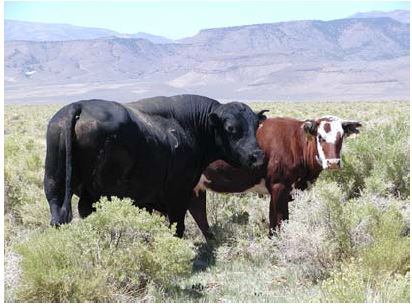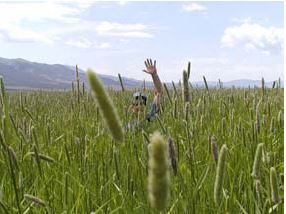INTRODUCTION
As fuel costs continue to increase, many sectors of the marketplace may be negatively impacted with regard to profits including crop and livestock production. This publication examines the changes created by increased fuel costs on net returns of various agricultural enterprises throughout northern Nevada and is intended to reflect impacts on potential returns. Practices described are based on the production practices considered typical for these crops, livestock operations and region, but may not apply to every situation.
TRENDS IN DIESEL EXPENSES
Although diesel fuel prices fluctuate cyclically, there has been a constant upward trend since the turn of the century, mimicking regular gas prices.
In May of 2002, regular diesel retailed for $1.31 per gallon (EIA, 2008). Thirty-six percent of that cost was taxes, creating a price of approximately $0.82 per gallon for diesel for off-highway use. Since 2002, prices continued to escalate and the percentage allotted to taxes continually declined, narrowing the gap between conventional and agricultural diesel prices. Fuel expenditures for farms rose thirty-six percent just between 2004 and 2005 (Shoemaker et al., 2006). In August of 2006, regular diesel averaged $3.05 per gallon; taxes accounted for 17.5 percent of that cost resulting in an off-highway diesel cost of $2.52 per gallon (EIA, 2008).
Source: GasBuddy.com – historical price chart for Nevada
*graph here
The current published data from the Energy Information Administration, who compiles the official energy statistics for the U.S. government, reports a cost of $4.30 for a gallon of regular diesel in August 2008 with the percentage of taxes on that gallon of fuel comprising 10.8 percent. Thus, the cost of a gallon of diesel is $3.84 when taxes are excluded. The difference between the 2006 price of $2.52 and the 2008 price of $3.84 for a gallon of red dye diesel represents an increase of fifty-three percent.
Source: Energy Information Administration
*graph here
It is widely recognized that this increasing trend in the expense of diesel for agricultural producers could have significant impacts on producer profits. Research has been conducted to determine the extent of these impacts, ranging from case studies to practical working papers that help producers estimate changes. Examples include the “Impact of Fuel and Nitrogen Prices on Profitability of Selected Crops: A Case Study” by Skalsky et al. in 2008 and “Estimating the Effect of Fuel Price Increases on Your Operation” by Dorn, also in 2008.
EFFECTS ON NEVADA ENTERPRISE BUDGETS
All changes to the enterprise budgets and the resulting differences in net returns were based on increasing the cost of machinery fuel and lubrication expenses by fifty-three percent, the difference between the 2006 and 2008 offhighway diesel per gallon costs (See Tables 1 & 2 for example). Additional impacts to producers resulting from higher fuel costs such as increased expenses of nitrogen based fertilizers or increased irrigation pumping expenses were not included in this analysis.
Farms and Ranches
Six differing representative farms and ranches were chosen for this analysis. These farms and ranches include alfalfa producers in Pershing County and Northwestern Nevada (Washoe, Storey, Douglas, Lyon, and Mineral Counties), onion producers in Northwestern Nevada, and cowcalf operations in Elko, Lyon and Pershing Counties. Acreage varied between 400 and 750 acres for crop production and herd size varied between 350 and 700 head for the cow-calf operations.
Fuels
For purposes of this analysis, the fuel under consideration was ‘red dye’ diesel. Red dye diesel is a tax-exempt diesel fuel that is created to be used for off-road agricultural production activities. This analysis only includes the increase in costs of operating the farm machinery and vehicles that utilize red dye diesel, not the increased costs of either electricity or other sources of fuel.
Alfalfa
Alfalfa is grown throughout the state on a total of 265,000 acres (NASS, 2008). Although it varies in the amount and quality of production, it is the leading cash crop in Nevada (NDA, 2008). Most alfalfa is grown for alfalfa hay and is exported to surrounding states as animal feed.

Pershing County
The Pershing County alfalfa enterprise budget is based on 750 acres of production. Prior to the increase, fuel and lubrication costs were $38,080.00 annually. After the adjustments to the budget, total fuel and lubrication costs increased to $58,262.40. Net returns dropped from $36,555.12 to $11,553.65 for the entire farm. On a per-acre basis, net returns dropped from $48.74 to $15.40 per acre of production.
Northwestern Nevada
The Northwestern Nevada alfalfa enterprise budget is based on 400 acres of production. Prior to the increase, fuel and lubrication costs were $51,563.36 annually. After the adjustments to the budget, total fuel and lubrication costs increased to $78,891.94. Net returns dropped from a profit of $33,057.47 to a loss of ($823.14) for the entire farm. On a peracre basis, net returns dropped from $82.64 to a loss of ($2.06) per acre of production.
Onions
The Northwestern Nevada onion enterprise budget is based on 400 acres of production of a combination of red, white and yellow bulb onions. Prior to the increase, fuel and lubrication costs were $118,587.12 annually. After the adjustments to the budget, total fuel and lubrication costs increased to $181,438.29. Net returns dropped from a profit of $16,063.39 to a loss of ($48,421.91) for the entire farm. On a per-acre basis, net returns dropped from $40.16 to a loss of ($121.05) per acre of production.
Cow-Calf Operations
Cattle ranching occurs primarily in the northern part of Nevada and is the leading agricultural industry (NDA, 2008). Although Nevada has stocker operations and feedlots, cow-calf operations are the primary enterprise, averaging 500,000 total head in 2007 (NASS, 2008).
Pershing County
The Pershing County cow-calf enterprise budget is based on production of 500 head of cattle. Prior to the increase, fuel and lubrication costs were $13,439.20 annually. After the adjustments to the budget, total fuel and lubrication costs increased to $20,427.58. Net returns dropped from a profit of $3,172.57 to a loss of ($3,997.51) for the entire ranch. On a per head basis, net returns dropped from $6.35 profit per head to a loss of ($8.00) per head of production.
Lyon County
The Lyon County cow-calf enterprise budget is based on production of 350 head of cattle. Prior to the increase, fuel and lubrication costs were $5,810.67 annually. After the adjustments to the budget, total fuel and lubrication costs increased to $8,890.33. Net returns dropped from a profit of $534.04 to a loss of ($2,705.76) for the entire ranch. On a perhead basis, net returns dropped from $1.53 profit per head to a loss of ($7.73) per head of production.
Elko County
The Elko County cow-calf enterprise budget is based on production of 700 head of cattle. Prior to the increase, fuel and lubrication costs were $11,466.51 annually (See Table 1). After the adjustments to the budget, total fuel and lubrication costs increased to $17,543.76. Net returns dropped from $7,192.44 to $940.17 for the entire ranch. On a per-head basis, net returns dropped from $10.27 per head to $1.34 per head of production (See Table 2).
Table 1. Elko County 700 Cow-Calf Production Costs and Returns, 2006
*table here
Table 2. Elko County 700 Cow-Calf Production Costs and Returns, 2006 Adjusted
*table here
SUMMARY
Although all of the budgets under consideration were negatively impacted by the increase in fuel prices, the impacts were largest on the smaller operations that are unable to distribute those costs across acres or number of cattle. Additionally, the impacts will vary depending on the amount of machinery utilized for crop or livestock production. Those enterprises utilizing the largest amount of machinery are the most affected by the increasing fuel costs. This is corroborated by a similar study in Wyoming that found differences in the impact of rising fuel prices on profit by crop (Skalsky et al., 2008). Nevada is additionally vulnerable to changes in fuel costs because of the arid climate; “variation in the regional distribution of energy input costs suggests that changes in energy prices would most affect producers in regions where irrigation is indispensable for crop production (Shoemaker et al., pg. 19, 2006)”. Because Nevada ranches and farms encompass large areas and are often distant from brokers or buyers, rising fuel prices may also impact the cost of transporting goods to market. For Nevada producers to remain solvent when faced with continually rising fuel costs, both directly as increased diesel prices to operate equipment and machinery for tillage, harvest and irrigation, and indirectly as petroleum products prices such as nitrogen fertilizers increase, increasing the price received for their goods may be one of the few options available.
NOTES
Sample production costs and returns publications for significant agricultural products in various regions of Nevada including all enterprises that are represented in this publication are available online at the University of Nevada Cooperative Extension Web site at UNCE. For additional information, contact the Department of Resource Economics at the University of Nevada, Reno at (775) 784-6701 or your local University of Nevada Cooperative Extension office.

REFERENCES
Dorn, T. (2008 Apr). Estimating the Effect of Fuel Price Increases on Your Operation. Crop Watch, 4(5).
Energy Information Administration (EIA) (2008). Official Energy Statistics from the U.S. Government - Diesel Fuel Component History Estimating the Effect of Fuel Price Increases on Your Operation Accessed September 2008.
National Agricultural Statistics Service (NASS) (2008). Online at: National Agricultural Statistics Service Database accessed September 2008.
Nevada Department of Agriculture (NDA) (2008). Agriculture in Nevada. Nevada Department of Agriculture Accessed September 2008.
Skalsky, S., Jacobs, J., Menkhaus, D., & Stevens, W. (2008 July-Aug). Impact of Fuel and Nitrogen Prices on Profitability of Selected Crops: A Case Study. Agronomy Journal, 100(4), p. 1161-1165.
Shoemaker, R., McGranahan, D., & McBride, W. (2006 Apr). Agriculture and rural communities are resilient to high energy costs. Amber Waves: The Economics of Food, Farming, Natural Resources, and Rural America, 4, no. 2, p. 16-21
Bishop, C. and Curtis, K.
2008,
The Impacts of Increasing Fuel Costs on Nevada’s Agricultural Enterprises,
Extension, University of Nevada, Reno


